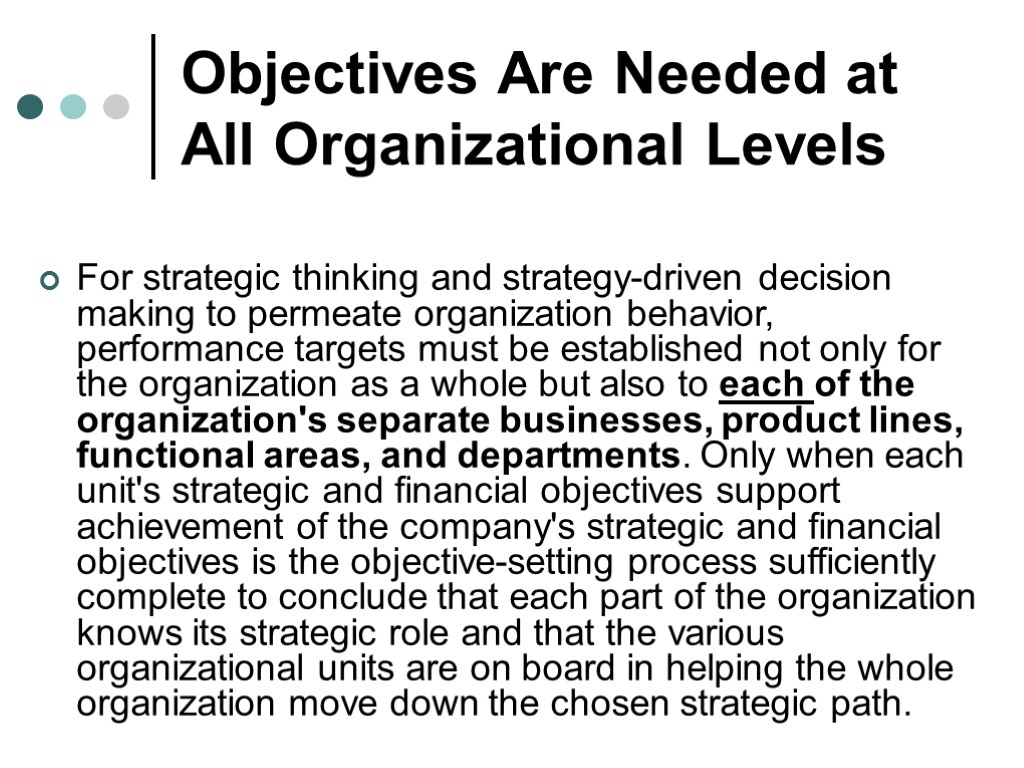ESTABLISHING OBJECTIVES: THE SECOND DIRECTION-SETTING TASKWhat is objective?

ESTABLISHING OBJECTIVES: THE SECOND DIRECTION-SETTING TASK

What is objective? Setting Objectives Converts the Strategic vision and directional course into specific performance targets. Objectives represent a managerial commitment to achieving specific performance targets within a specific time frame. They are a call for action and for results.

Managers should translate mission into specific targets Unless an organization's long-term direction and business mission are translated into specific performance targets and managers are pressured to show progress in reaching these targets, vision and mission statements are likely to end up as nice words

Objectives for every key result The experiences of countless companies and managers teach that companies whose managers set objectives for each key result area and then press forward with actions aimed directly at achieving these performance outcomes typically outperform companies whose managers exhibit good intentions, try hard, and hope for the best.

Requirements to objectives For objectives to function as yardsticks of organizational performance and progress they must be stated in quantifiable or measurable terms and they must contain a deadline for achievement. They have to spell out how much of what kind of performance by when. This means avoiding generalities like "maximize profits." "reduce costs," "become more efficient," or "increase sales", which specify neither how much nor when.

SMART technology for objectives creating Objectives must be 1. Specific 2. Measurable 3. Achievable . 4. Related 5. Time–bound

What Kinds of Objectives to Set Two types of key result areas stand out: those relating to financial performance and those relating to strategic performance.

Every company needs both strategic objectives and financial objectives. Achieving acceptable financial performance is a must; otherwise the organization's financial standing can alarm creditors and shareholders, impair its ability to fund needed initiatives, and perhaps even put its very survival at risk. Achieving acceptable strategic performance is essential to sustaining and improving the company's long-term market position and competitiveness.

Financial Objectives Growth in revenues Growth in earnings Higher dividends Wider profit margins Higher returns on invested capital Strong bond and credit ratings Bigger cash flows A rising stock price

Strategic Objectives A bigger market share Quicker design-to-market times than rivals Higher product quality than rivals Lower costs relative to key competitors Broader or more attractive product line than rivals A stronger reputation with customers than rivals Superior customer service Recognition as a leader in technology and/or product innovation Wider geographic coverage than rivals Higher levels of customer satisfaction than rivals

Strategic Objectives versus Financial Objectives: Which Take Precedence? Strategic Management Principle: Building a stronger long-term competitive position benefits shareholders more lastingly than improving short-term profitability

The Concept of Strategic Intent A company's strategic objectives are important for another reason - they indicate strategic intent to stake out a particular business position. The strategic intent of a large company may be industry leadership on a national or global scale. The strategic intent of a small company may be to dominate a market niche. The strategic intent of an up-and-coming enterprise may be to overtake the market leaders. The strategic intent of a technologically innovative company may be to pioneer a promising discovery and create a whole new vista of products that change the way people work and live.

The Need for Long-Range and Short-Range Objectives Objective setting should result in both long-range and short-range performance targets.

How Much Stretch Should Objectives Entail? As a starter, objectives should be set high enough to produce outcomes at least incrementally better than current performance. But incremental improvements are not necessarily sufficient, especially if current performance levels are subpar. At a minimum, a company's financial objectives must aim high enough to generate the resources to execute the chosen strategy proficiently.

Objectives Are Needed at All Organizational Levels For strategic thinking and strategy-driven decision making to permeate organization behavior, performance targets must be established not only for the organization as a whole but also to each of the organization's separate businesses, product lines, functional areas, and departments. Only when each unit's strategic and financial objectives support achievement of the company's strategic and financial objectives is the objective-setting process sufficiently complete to conclude that each part of the organization knows its strategic role and that the various organizational units are on board in helping the whole organization move down the chosen strategic path.
lec3=establishing_objectives.ppt
- Количество слайдов: 15
